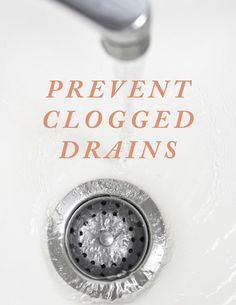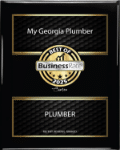
Your drain is working perfectly fine, or so you think until it experiences a clog. Now, you have to spend a lot of time and money to clear the clog before you can use your sink again.
You can prevent clogged drains by maintaining and caring for your drain every day. Here are a few simple steps to keep your drain pipes clean and promote a healthy plumbing system.
1. Pay Attention to Water Temperature
You may prefer to wash your hands in tepid water. But did you know that very hot water can break up grease deposits that are lurking in your drain? Make sure you run hot water at least once a week.
However, there’s one time when you should run cold water, not hot: when you run your disposal. When you run your disposal with hot water, the hot water could cause the grease to melt and coat the drain. Cold water will keep the grease in a solid form so the disposal can break it down and prevent clogging the drain.
2. Set Grease Aside
Speaking of grease, it’s best to keep it out of the disposal as much as possible. Oil and grease can bond with each other and with other solids to create giant clogs. Instead of pouring oil and grease down the kitchen drain, you should pour it into an old can or container and then throw it away.
3. Use a Drain Trap
There are certain substances, such as soap scum, crumbs, and hair, which struggle to flow down the drain. These substances often get trapped in shower drains, but they can also get trapped in kitchen and bathroom drains.
To prevent a blockage, place a drain trap over the sink opening. Nonliquid substances will sit in the drain trap rather than flowing down the drain. You can then remove the drain trap and throw the substances into the garbage.
If you’re afraid your drain is about to develop a clog, you can clean it out with any of the following methods.
Pour a half cup of baking soda into the drain. Next, pour one-fourth of a cup of white vinegar on top of the baking soda and then a half cup of salt on top of both. Leave the drain for 15 minutes, and then pour boiling water into the sink.
For built-up grease and oil, pour about a tablespoon of dish liquid into the drain. Then, slowly pour boiling water into the drain. The soap and water should dissolve and wash away the grease.
For bathroom drains, try pouring a tablespoon of salt in the drain. Pour one-fourth of a cup of white vinegar on top of the salt, and then leave your drain alone. An hour later, run hot water down the drain.
Remember that when you pour boiling water, you should wear gloves to protect your hands.
You can also keep your drain clear by adding bleach every so often. Pour a small amount of bleach down the drain and leave it for an hour or more before you turn on the water again.
5. Keep Certain Substances Out
You can do your part to prevent clogs by placing the following in the garbage rather than the drain:
Eggshells
Coffee grounds
Household cleaning products
Medications
Paper towels
Produce stickers
Napkins
Fruit peels
Disposals have a hard time breaking down these substances, and they could cause major drain blockages.
Follow these steps to keep your drains clean and clear, and you can avoid everyday drainage problems. But sometimes, clogs happen despite your best efforts. A stubborn clog is difficult to remove without the right training and equipment.
If your drain clogs, call a plumber. An experienced plumber can remove the clog at its source so you can enjoy a clear drain again.
6 easy ways to fix a clogged drain
Clogged drains are usually the result of a foreign object or debris getting stuck in a drain pipe, or built-up residue that chokes off the flow. The cause of a clog and the fix for it may vary depending on what kind of sink it is. For example, a kitchen sink clog might present different challenges than other sinks in the home because of the nature of what goes into the drain.
But wherever they are in the home, it’s important to fix clogged drains as soon as you find them. If the problem goes unfixed for too long, water can begin to back up. And no one wants to have to fix water damage. The more drain cleaning techniques you know, the quicker you can resolve the problem.
1. Pour boiling water down your drains.
One of the easier and more affordable ways to fix a clogged sink drain is with boiling water, so it should be one of the first things you try:
Using a cup or container, remove as much standing water from the sink as possible.
Pour an entire pot or kettle of boiling water directly into the drain.
If needed, remove the standing water again, after it has cooled, and then pour salt down the drain before more boiling water. Let it sit before flushing again with hot water to clear.
Repeat until the clog is cleared.
2. Use a plunger to remove debris.
It might take some patience and a little practice, but a plunger can be another cost-effective solution for fixing clogged sink drains:
If you have a double-basin sink, cover the drain on the side that isn’t clogged (the pressure of plunging could cause water or debris to spray up the other drain).
Add a couple inches of hot water to the clogged sink’s basin. This will allow you to create a seal between the plunger and the drain.
Once you’ve got the plunger tightly sealed to the drain, start pumping up and down for a few seconds.
Repeat this process until the water in the sink drains.
Although any plunger will likely do the trick, you may want to invest in a mini-plunger designed specifically for clogged sink drains.
3. Check your garbage disposal for any potential clogs.
If the hot water and plunger haven’t helped to remove your kitchen sink clog, the problem may be your garbage disposal, if you have one. Here’s how to check:
With water running, turn on the garbage disposal. This should clear any debris that could be clogged in the unit.
If the disposal isn’t working or begins to make a humming noise, there could be a bigger problem, such as a jam or broken machinery.
You can fix a jam yourself, but it may be best to call in a professional for help.
Home appliance maintenance can be tricky, so when it comes to checking your garbage disposal, you’ll want to watch out for safety hazards and be careful not to damage the mechanism. For example, you should cut the electricity to your garbage disposal before making any repairs.
4. Unclog drains with baking soda and vinegar.
Often a sink clog can be remedied with drain cleaner, which is available at your local hardware or home improvement store. But you could also try a homemade drain cleaner, like vinegar and baking soda:
Start by adding some dish soap and hot water to the clogged drain. Make sure no standing water remains.
Next, pour 1 cup of baking soda into the drain. Use a funnel to avoid spillage if needed.
Continue by adding 1 cup of white vinegar.
Wait about 15 minutes and then flush the drain with another 2 cups of hot water.
Repeat this process if necessary.
A variation on this technique is to combine baking soda with salt and pour it down the drain. This homemade drain cleaner would need to sit for several hours, though, and then be flushed with boiling water.
5. Purchase a drain snake.
A drain snake is a simple tool that can be used for preventing clogging the drain. It’s a long, flexible metal cable with an auger, or drill, on the end for breaking up clogs. To use a drain snake:
Begin by removing the trap from your drain.
Feed the snake’s cable down the drain until it reaches the object causing the clog.
Use the drain snake to break the clog apart and remove it from the drain.
You can purchase either an electric or hand-powered drain snake. Or you can use plastic clog removers, which are long and thin with little teeth on the sides to snag debris that may be built up. The best choice for you will depend on both your budget and your level of experience using plumbing tools. Or, in a pinch, you could also try using a straightened wire coat hanger instead.
6. Clean your sink’s P-trap.
Most sinks have a P-trap, a curve of the drainpipe that’s usually in the cabinet underneath the sink. To see if this is the source of your clog, you’ll want to:
Place a small bucket underneath your drainpipe. This will help catch any water that may have settled in the pipe.
Unfasten the P-trap from the drainpipe.
Clean the interior of the pipe that surrounds the P-trap.
Clean the P-trap itself and then position it back in place.
If the clog is located well past the trap, you can use a drain snake to clear the unreachable areas.
Preventing clogged drains in your home
As they say, an ounce of prevention is worth a pound of cure, and the same applies when dealing with a clogged drain. Even if you’ve become a pro at using homemade drain cleaners, you’d much rather not have the problem at all. Luckily, there are several things you can do to avoid clogged drains:
Properly dispose of grease and oil. Grease catches food particles and debris, which creates a blockage. That’s why it’s essential to take care when disposing of grease and oil in the sink. Find alternate methods when possible, and when you must dump small amounts of grease down the drain, always run hot water.
Keep coffee grounds and leftover food out of your drains. Though a small scrap here and there may seem harmless, it’s best to keep all leftover food out of your drains. This is especially true for coffee grounds, since they clump together in water and can build up in your drains over time.
Maintain your garbage disposal. Keep your garbage disposal clean and always run water when using it. In a sink without a disposal, use a strainer to catch pieces of food and debris to place in the trash.
Use drain covers when possible. In the bathroom, use a drain cover or strainer to catch as much hair as possible. Clean the visible areas of drain openings frequently when you see debris has begun to collect. You can also purchase a low-flow faucet to help save energy in the bathroom.
Clean your sink drains routinely. Even something as simple as pouring a few cups of hot water in your drains each week can help prevent blockages. You can also make deep-cleaning your drains part of your spring-cleaning routine.
The importance of keeping your sink drains clean
Most of us can’t fix every problem that arises in our homes — like flooding from corroded water pipes or a broken water main — but even learning how to regularly unclog a drain with baking soda can save some time and money on more extensive measures and expensive plumber fees. What’s more, standing water leaves deposits of scum on the sides of the sink, which requires more water to clean, which doesn’t fully drain, leaving fresh deposits, and the cycle continues. When you fix clogged drains in your home, it helps reduce your overall water consumption and may lower your bill.
There are also environmental benefits of regular drain cleaning. Less water consumption means less energy used in water treatment, so if your power comes from fossil fuels, that’s less carbon emitted into the atmosphere. Plus, using DIY cleaning supplies that are environmentally friendly helps not only our planet but also your plumbing, which can be harmed by powerful chemical drain cleaners. Many tasks can be done in an eco-friendly way — there are even natural remedies for pest control!










